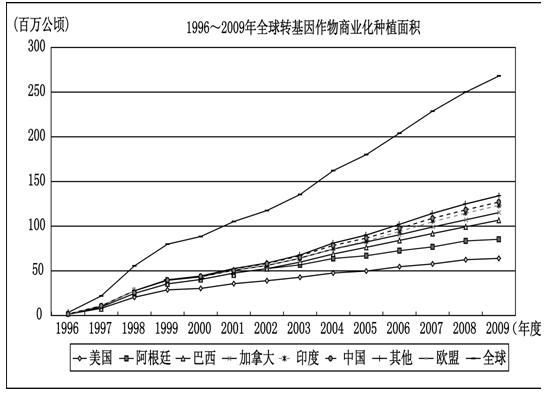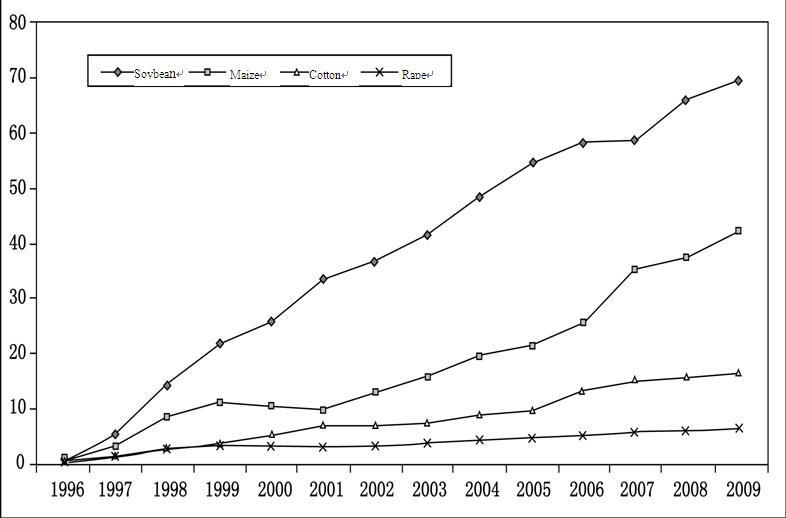Be Cautious about GMF Crop Commercialization
Aug 30,2011
Chen Jianpeng
At the end of 2009, the Ministry of Agriculture approved the safety certificate for three genetically modified rice and maize varieties. This move represented a crucial step taken by China in commercializing the cultivation of genetically modified food (GMF) crops and immediately triggered a huge controversy. Modern agro-biotechnologies are an important technological guarantee for food security and sustainable agricultural development and their application in agricultural production is a trend of the times. The fact that China must conquer the highland of agro-biotechnologies is not only a technological and economic issue but also a political one. But when we come to the agro-biotechnology development strategy and especially the commercialization of specific GMF crops (rice, wheat and other basic food crops in particular), decisions should be made with great caution and on the basis of in-depth study.
I. Present State of GM Crop Commercialization
1. Rapid Growth of GMF Crop Acreage and Market Share
The 2009 report of the International Service for the Acquisition of Agri-biotech Applications (ISAAA) indicates that the acreage of GM crops increased from 1.7 million hectares in 1996 to 134 million hectares in 2009, an 80-fold growth. In 2009, 25 countries were growing GM crops. According to the 2008 report of the International Seed Federation (ISF), the global market value of commercial seeds was about 36.5 billion dollars and the global sale of GM crop varieties totaled 7.5 billion dollars. Based on this information, the sale of GM seeds roughly account for 20.5% of the global sale of commercial seeds. The sale of GM seeds has been on a rapid rise since 1996 (see the table below).
Global Sale of GM Seeds
|
Year |
1996 |
2000 |
2004 |
2006 |
2007 |
2008 |
2009 |
|
Sale (million dollars) |
115 |
2703 |
4663 |
6150 |
6900 |
7500 |
8300 |
Note: The 2009 data were ISAAA projections.
Source: US Department of Agriculture:Seed Info 2008,ISAAA.
2. GM Crops Mostly Commercialized in USA, Brazil and Argentina
In 2009, the GM crop cultivation acreage in the United States, Brazil and Argentina was respectively 64 million hectares, 21.4 million hectares and 21.3 million hectares. While they respectively accounted for 47.8%, 16% and 15.9% of the global acreage of GM crop cultivation, their combined share was as high as 79.7%. Of the 27 members of the European Union, six countries, namely Spain, Czech, Portugal, Romania, Slovakia and Poland, cultivated 94,750 hectares of Bt maize, a GM variety resistant to insects. At present, the general trend is that the United States is the most active promoter of GM crops, Europe is cautious and resistant to GM crops and Africa as a whole refuses GM crops (See attached table 1 for detailed information).
Global Acreage of GM Crop Commercialization
Million hectares

Figure 1 Global GM Crop Commercialization
Source: Based on ISAAA reports.
3. Soybean, Maize, Cotton and Rape Are Main GM Crops
Since the commercialization of GM crop cultivation began in 1996, soybean, maize, cotton and rape have been the four main GM crops around the world. In 2009, the acreages of GM soybean, maize, cotton and rape were respectively 69.2 million hectares, 41.7 million hectares, 16.1 million hectares and 6.4 million hectares, and respectively accounted for 52%, 31,%, 12% and 5% of the global GM crop cultivation. In terms of the ratios of GM varieties to their global cultivation acreages, the four GM crops respectively accounted for 77%, 49%, 26% and 21% (see attached table 2 for detailed information about global commercialization of GM crop varieties).

Figure 2 Global Acreages of Main GM Crop Cultivation 1996~2009 (million hectares)
Source: Clive James, 2010.
4. A Few Multinational Companies Dominate GM Crop Market
A few multinational companies are dominating agro-biotechnologies, and developed countries are dominating the intellectual properties of GM crop varieties and technologies. Take the most popular insect resistant genes and weed killer resistant genes as an example. Currently, more than 70% of insect resistant genes around the world are controlled by five multinational companies. They are Monsanto, Bayer, Vanguard, Syngenta and Dow AgroSciences. About half of the patent of the Cry gene (one of the most important insect resistant genes) which has been authorized by China, is also controlled by these companies. About 63% of weed killer resistant genes are controlled by Monsanto, Bayer, DuPont-Vanguard and Syngenta.
At present, the international seed market is monopolized by magnates. According to ETC Group data, the global market share of the world top 10 seed companies rose from 37% in 1996 to 57% in 2006. In particular, Monsanto, DuPont-Vanguard, Syigenta and Bayer together accounted for 41% of the global seed market. Monsanto, the world's largest seed company, now dominates the markets of soybean, maize, rape, vegetable and other crop seeds.
II. China's Policy Evolution and Main Arguments over GMF Commercialization
1. Recent Change of China's Policy on GMF Commercialization
Since the 1990s, the Chinese government has been cautious about the commercialization of GM crops and especially the main food crops such as rice, wheat and maize. In 2001, China promulgated the Regulations on the Administration of the Biological Security of Genetically Modified Agricultural Organisms. Since then, China has formally approved the commercial production of GM cotton, tomato, sweet pepper, petunia, white poplar and pawpaw. But only GM cotton has been truly commercialized on a large scale and in many varieties. After the insect resistant GM cotton, no major GMF crop has been approved for commercial production.
Since the 2008 "food crisis", however, China's policy preference on GMF commercialization has somewhat changed. In July 2008, the executive meeting of the State Council examined and approved in principle a major scientific program on the cultivation of new GM bio-varieties. The Long and Medium-Term National Program on Food Security promulgated in November 2008 again explicitly launched a major scientific program on new GM bio-varieties. And in December 2009, the Ministry of Agriculture approved the safety certificate for three GM varieties, namely two GM rice varieties (Huahui-1 and Bt Shanyou-63) and one GM maize variety (BVLA430101). The three varieties may go for commercial production after obtaining the certificate of variety approval, the GM seed production permit and the business permit. In its No. 1 document issued in 2010, the Party Central Committee said commercialization of new GM varieties would be promoted on the basis of scientific assessment and management according to the law. Accordingly, the policy on main GMF varieties is likely to switch from whether they should be commercialized to when they will be commercialized.
2. Main Arguments over China's GMF Crop Commercialization
The first argument is over the impact of GMF crop commercialization on food security. The proponents argue that GM crops will play important roles in ensuring food security both in the world and in China. The opponents argue that currently the GM crops have little importance to ensuring food security. The second argument is over the impact of GM crop commercialization on agro-biotechnology industry, seed industry and peasant income. The proponents argue that GMF crop commercialization should be promoted as soon as possible to accelerate the development of China's biotechnology industry. The opponents argue that GMF crop commercialization may accelerate foreign capital control over China's seed industry and be harmful to the development of China's agro-biotechnology industry.
The third argument is over the impact of GM crop commercialization on ecological and human health. The proponents argue that GM crops do not have more environmental risks than traditional crops do and are safe when used as food. The opponents argue that GMF crops have undeniable potential risks toward ecological environment and human health.
...
If you need the full context, please leave a message on the website.














